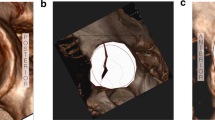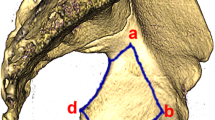Abstract
Introduction
Associated both-column acetabular fractures (ABC-AF) are complex. A detailed description of the morphology of the articular surface of the acetabulum is not reported. This study was designed to describe the morphology of the intra-articular fragments using a fracture mapping technique to provide reference in more appropriate approach selection in surgical treatment of the fractures.
Materials and methods
Three-dimensional reconstruction CT images from 100 cases of ABC-AFs were retrospectively analyzed using Mimics and 3-matic software. The fractured as well as the reduced three-dimensional models were investigated, and the intra-articular fragments were identified. The distribution of the fracture lines of each main fragment and the overlapping lines of all the fragments were verified on the images.
Results
The articular surface of ABC-AFS consist of three types of fragments: column fragment (CF), wall fragment (WF) and isolated fragment (IF), with the total number varying from 2 to 6. CF characterized by long fracture lines exited to periphery of innominate bone while the lines of WF were confined to the walls. IF was a free fragment found in the dome and in the quadrilateral plate. The surface was composed only by CFs in 17 cases (17%), by CFs and WFs in 59 cases (59%) and by all fragments in 24 cases (24%). The distribution of the overall fracture lines was a “dumbbell shaped” pattern, starting from the infero-anterior aspect, passing through the junction of the fossa to the anterior lunate surface and extending into the posterior region of the acetabulum.
Conclusions
The articular fragments of ABC-AFs were composed of CFs, WFs and IFs. The junction of the fossa to the anterior lunate surface and the posterior region of the rim were mostly involved. The location of the articular fragments and their connections to the periphery of the innominate may be considered in selection of approaches.







Similar content being viewed by others
References
Briffa N, Pearce R, Hill AM, Bircher M (2011) Outcomes of acetabular fracture fixation with ten years’ follow-up. J Bone Joint Surg Br 93(2):229–236
Casstevens C, Archdeacon MT, d’Heurle A, Finnan R (2014) Intrapelvic reduction and buttress screw stabilization of dome impaction of the acetabulum: a technical trick. J Orthop Trauma 28(6):e133-137
Chen K, Ji Y, Huang Z et al (2018) Single modified ilioinguinal approach for the treatment of acetabular fractures involving both columns. J Orthop Trauma 32(11):e428–e434
Collinge CA, Lebus GF (2015) Techniques for reduction of the quadrilateral surface and dome impaction when using the anterior intrapelvic (modified Stoppa) approach. J Orthop Trauma 29(Suppl 2):S20-24
ElNahal WA, Abdel Karim M, Khaled SA, Abdelazeem AH, Abdelazeem H (2018) Quadrilateral plate fractures of the acetabulum: proposition for a novel classification system. Injury 49(2):296–301
Giannoudis PV, Grotz MR, Papakostidis C, Dinopoulos H (2005) Operative treatment of displaced fractures of the acetabulum. A meta-analysis. J Bone Joint Surg Br 87(1):2–9
Giannoudis PV, Tzioupis C, Papathanassopoulos A, Obakponovwe O, Roberts C (2010) Articular step-off and risk of post-traumatic osteoarthritis. Evid Today Injury 41(10):986–995
Hadad MJ, Sullivan BT, Sponseller PD (2018) Surgically relevant patterns in triplane fractures: a mapping study. J Bone Joint Surg Am 100(12):1039–1046
Harris AM, Althausen P, Kellam JF, Bosse MJ (2008) Simultaneous anterior and posterior approaches for complex acetabular fractures. J Orthop Trauma 22(7):494–497
Isaacson MJ, Taylor BC, French BG, Poka A (2014) Treatment of acetabulum fractures through the modified Stoppa approach: strategies and outcomes. Clin Orthop Relat Res 472(11):3345–3352
Keel MJ, Ecker TM, Cullmann JL et al (2012) The Pararectus approach for anterior intrapelvic management of acetabular fractures: an anatomical study and clinical evaluation. J Bone Joint Surg Br 94(3):405–411
Keel MJ, Ecker TM, Siebenrock KA, Bastian JD (2012) Rationales for the Bernese approaches in acetabular surgery. Eur J Trauma Emerg Surg 38(5):489–498
Laflamme GY, Hebert-Davies J (2014) Direct reduction technique for superomedial dome impaction in geriatric acetabular fractures. J Orthop Trauma 28(2):e39-43
Lichte P, Sellei RM, Kobbe P, Dombroski DG, Gansslen A, Pape HC (2013) Predictors of poor outcome after both column acetabular fractures: a 30-year retrospective cohort study. Patient Saf Surg 7(1):9
Matta JM (2006) Operative treatment of acetabular fractures through the ilioinguinal approach: a 10-year perspective. J Orthop Trauma 20(1 Suppl):S20-29
Mears DC, Velyvis JH, Chang CP (2003) Displaced acetabular fractures managed operatively: indicators of outcome. Clin Orthop Relat Res 407:173–186
Molenaars RJ, Mellema JJ, Doornberg JN, Kloen P (2015) Tibial plateau fracture characteristics: computed tomography mapping of lateral, medial, and bicondylar fractures. J Bone Joint Surg Am 97(18):1512–1520
Pierannunzii L, Fischer F, Tagliabue L, Calori GM, d’Imporzano M (2010) Acetabular both-column fractures: essentials of operative management. Injury 41(11):1145–1149
Tannast M, Keel MJB, Siebenrock KA, Bastian JD (2019) Open reduction and internal fixation of acetabular fractures using the modified stoppa approach. JBJS Essent Surg Tech 9(1):e3
Tosounidis TH, Giannoudis VP, Kanakaris NK, Giannoudis PV (2018) The ilioinguinal approach: state of the art. JBJS Essent Surg Tech 8(2):e19
Tosounidis TH, Giannoudis VP, Kanakaris NK, Giannoudis PV (2018) The Kocher-Langenbeck approach: state of the art. JBJS Essent Surg Tech 8(2):e18
Xie X, Zhan Y, Dong M et al (2017) Two and three-dimensional CT mapping of Hoffa fractures. J Bone Joint Surg Am 99(21):1866–1874
Xie X, Zhan Y, Wang Y, Lucas JF, Zhang Y, Luo C (2020) Comparative analysis of mechanism-associated 3-dimensional tibial plateau fracture patterns. J Bone Joint Surg Am 102(5):410–418
Yang Y, Yi M, Zou C, Yan ZK, Yan XA, Fang Y (2018) Mapping of 238 quadrilateral plate fractures with three-dimensional computed tomography. Injury 49(7):1307–1312
Yang Y, Zou C, Fang Y (2019) Mapping of both column acetabular fractures with three-dimensional computed tomography and implications on surgical management. BMC Musculoskelet Disord 20(1):255
Yang Y, Zou C, Fang Y (2019) A study on fracture lines of the quadrilateral plate based on fracture mapping. J Orthop Surg Res 14(1):310
Funding
None.
Author information
Authors and Affiliations
Corresponding author
Ethics declarations
Conflict of interest
The authors have no relevant financial or non-financial interests to disclose.
Ethical approval
An ethical approval was granted from the internal review board at our institution [Approval number: 2020-KY-098(K)].
Informed consent
Informed consent was exempted by our Institutional Review Board.
Additional information
Publisher's Note
Springer Nature remains neutral with regard to jurisdictional claims in published maps and institutional affiliations.
Rights and permissions
About this article
Cite this article
Ye, K., Broertjes, K., Qin, H. et al. Intra-articular fragment mapping in associated both-column acetabular fractures. Arch Orthop Trauma Surg 143, 909–917 (2023). https://doi.org/10.1007/s00402-022-04381-w
Received:
Accepted:
Published:
Issue Date:
DOI: https://doi.org/10.1007/s00402-022-04381-w




